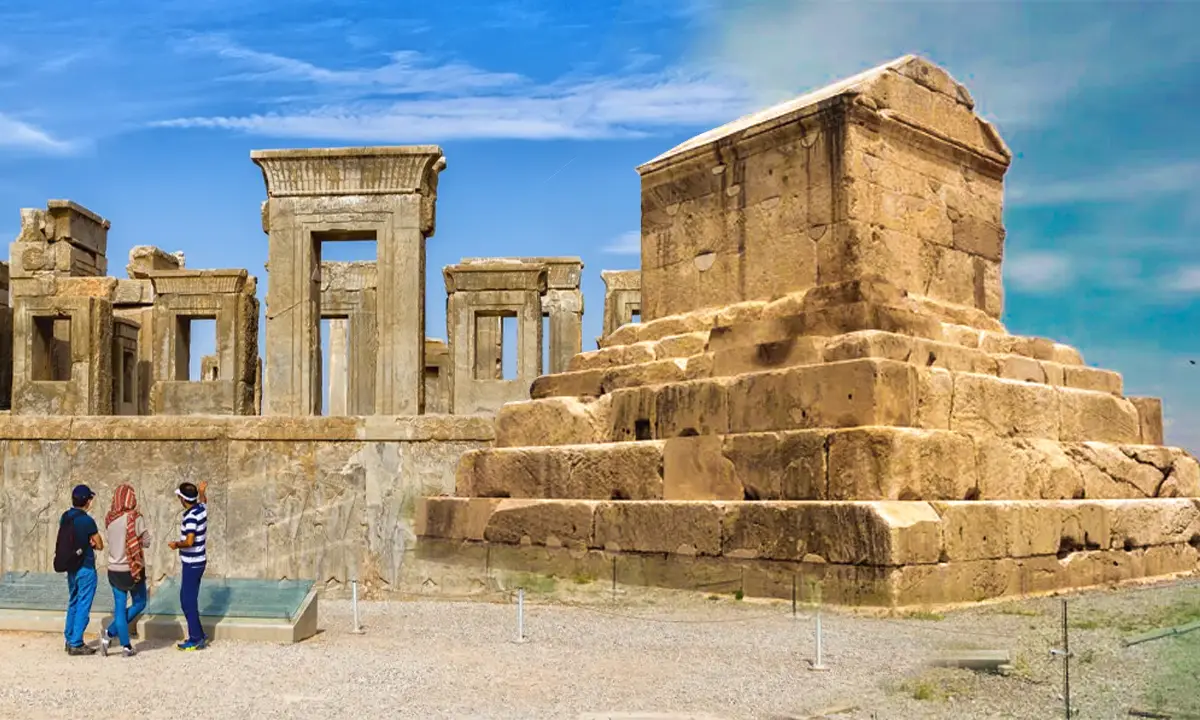Dubai Before and After, How Did Dubai Look Like in the Past?
![]() Author : asal | Date : Sunday 11 May 2025 12:23
Author : asal | Date : Sunday 11 May 2025 12:23
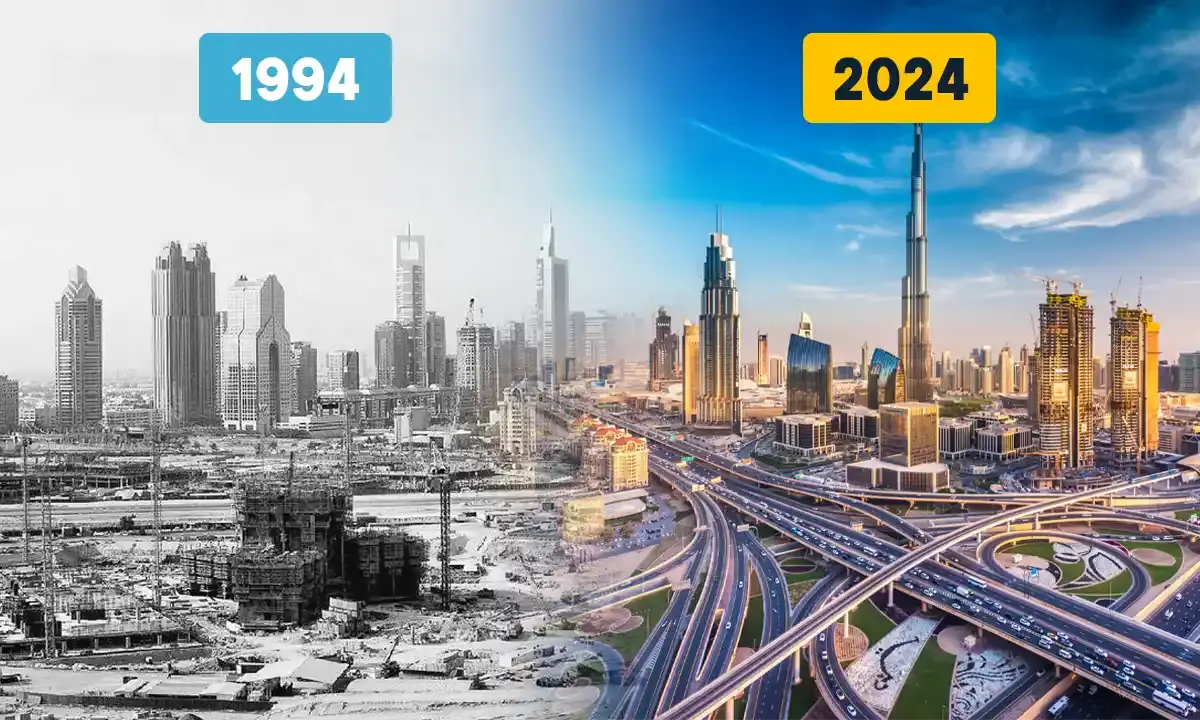
Dubai, which was once little more than a desert and a few basic structures, has now evolved into one of the world's most sophisticated cities. So, how did this happen? Is it possible to achieve so much progress in such a short time? How was Dubai before and after?
We'll explain the differences between old vs. new Dubai so you can observe the incredible changes that have occurred over the past several decades.
Now, let's dive into Dubai transformation and learn how the city has formed today.
First of All, Where is Dubai? - Dubai's Transformation
Dubai, following Abu Dhabi, is one of the seven emirates that make up the United Arab Emirates. Spanning an area of 4,150 square kilometers, it comprises less than 6% of the UAE's total landmass. Despite having a native population of fewer than 3 million people, Dubai is the most populous city in the region. This figure significantly increases to over 10 million, including immigrants. The city's origins trace back to 1833 when about 800 members of the Bani Yas tribe settled around a natural harbor created by the city's creek, developing it into a modest fishing and pearling hub. Later, Bedouin nomads joined, constructing simple homes known as 'baristas' along the creek.
In the 1960s, Dubai's economy primarily relied on trade and oil exploration concessions. The turning point in Dubai’s developmental history came in 1969 when oil revenue began to pour in, sparking rapid urban development. Substantial investments were made, leading to the swift establishment of essential infrastructure such as schools and hospitals. Over the years, Dubai has transformed into the vibrant global metropolis it is today.
The 21st-century Dubai is now a global destination with millions of residents. The endless attractions and wonders of this city attract over 16 million visitors annually. But with such a massive, modern city, getting around isn’t always simple. Relying on taxis or public transport can mean long waits, high costs, or missing out on places off the beaten path. The solution? Your own wheels. Renting a car gives you the freedom to explore Dubai’s old soul and new skyline, on your time, your route, your way. Check out car rental options in Dubai and make the city yours.
The History of Dubai: How Was Dubai in the Past?
Originally, Dubai was a humble hamlet, home to only a handful of impoverished families. As early as 1095 AD, this small village relied primarily on fishing as its main source of income. Throughout its history, Dubai witnessed numerous conflicts until Sheikh Maktoum bin Bati bin Suhail Al Maktoum ended the hostilities and gradually transformed it into a burgeoning city over time, marking a significant Dubai transformation.
Historical records indicate that the settlement now known as Dubai was established in 1799 A.D. Initially, it was a minor village under the administration of the sheikhdom of Abu Dhabi. The village remained relatively obscure until 1833 AD, when Sheikh Maktoum bin Bati Al Maktoum arrived with 800 of his kin. He embarked on a significant rebuilding and restoration project, dramatically changing the landscape of what was then known as Dubai Village, positioning it on the path to urbanization and further illustrating the Dubai before and after evolution.
Sheikh Al Maktoum's vision and strategic planning were pivotal in expanding Dubai from a modest village into a magnificent metropolis. His leadership marked the beginning of Dubai’s transformation into a modern city. Recognizing the potential of the small town, Sheikh Maktoum officially declared it a city. In the twentieth century, the development of a port in the Jebel Ali district capitalized on Dubai Village's advantageous location. Today, this port is recognized as one of the largest and most significant ports in the Middle East and ranks as the world's sixth-largest port, epitomizing Dubai before and after success story.
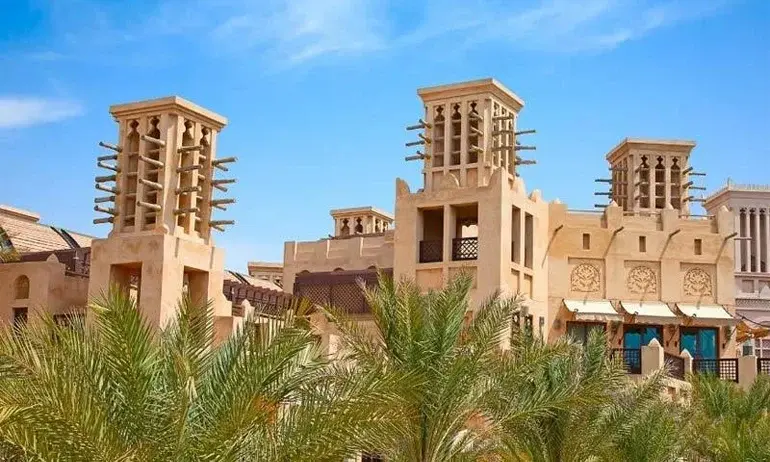
When Did Dubai Become Popular?
In 1902, Dubai experienced a significant influx of Arab residents and Persian traders. This led to the imposition of taxes on Iran's Lingeh Port, catalyzing Dubai's burgeoning trade sector. The discovery of oil near the Trucial States in the 1950s further propelled its economic growth. Consequently, Dubai's ascent truly began in the 1950s, setting the stage for the dramatic Dubai before and after transformation.
Therefore, if you're asked when Dubai's development truly started, the pivotal year to remember is 1969, marking a transformative era in its history and further highlighting the 'Dubai before and after' evolution.
1966: Oil is discovered in Dubai
1966 marked a pivotal year in Dubai's history with the discovery of oil, a cornerstone event that defined the 'Dubai before and after' narrative.
Oil was first discovered in significant quantities along the beaches of the Fateh region in 1966. By 1969, the extraction process was fully underway, culminating in the completion of three massive underwater oil tanks in the 1970s. Each tank boasts a capacity of 500,000 barrels, collectively known as the 'Triple Pyramids of Dubai.' These developments not only transformed the landscape but also propelled Dubai onto the global stage as a major oil producer.
Dubai Before and After: 2025 Dubai!
Have you ever looked at pictures of Dubai from 1960, 1961, or even earlier? Perhaps you've wondered: how did Dubai progress so quickly? This curiosity underscores the striking Dubai before and after transformation.
Following border conflicts in the late 1950s, Abu Dhabi thrived with significant oil revenues, while Dubai faced financial hardships. This situation compelled Dubai’s ruler, Sheikh Rashid bin Saeed Al Maktoum, to devise innovative and bold strategies. Viewing infrastructure as a key long-term economic driver, he invested heavily in constructing the international airport and port facilities, marking a pivotal chapter in the Dubai before and after story.
Dubai’s first airport opened in 1960, and the dredging of Dubai Creek began in 1963. Sheikh Rashid bin Saeed Al Maktoum had to secure billions of dollars in loans to fund these ambitious projects. The efforts paid off magnificently, transforming the port to accommodate ocean-going vessels and establishing the gold re-export sector, a testament to Dubai before and after economic revolution.
Today, Dubai stands as the retail, commercial, business, and investment capital of Africa and the Middle East, and as one of the world’s premier cities. Between the bustling Dubai International Airport and the sprawling Dubai Mall, the city boasts some of the most impressive infrastructure globally. Moreover, Dubai has become a prime global tourism destination, renowned for its luxurious hotels, unique resorts, and stunning desert landscapes.
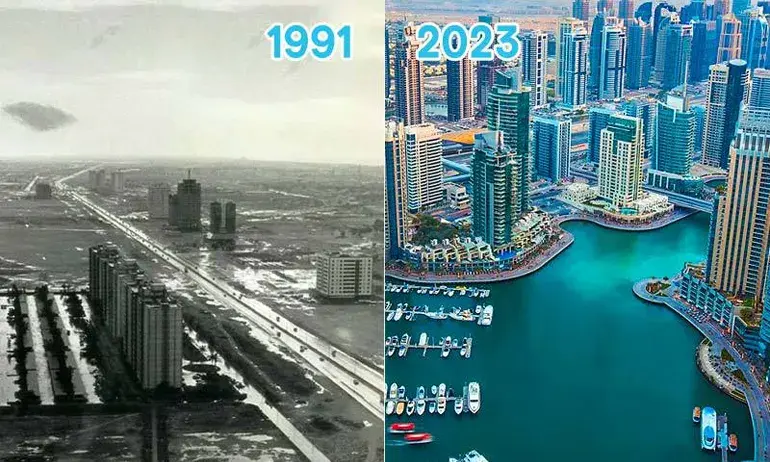
Dubai 50 Years Ago vs. Now
When reflecting on Dubai’s transformation over the past 50 years, the scale of change is astonishing. Imagine comparing Dubai in 2000 to Dubai in 2020—the evolution is almost unbelievable!
The departure of Britain from Hong Kong in the 1970s catalyzed a significant migration of British-Hong Kong capitalists and merchants to the UAE. This influx of investment into Dubai was a pivotal moment, sparking rapid development that has continued to accelerate over the decades.
While this wave of capital was crucial, it was just one of many factors propelling the UAE’s swift growth. Today, Dubai is not only a testament to its past achievements but also a beacon of modernity and innovation.
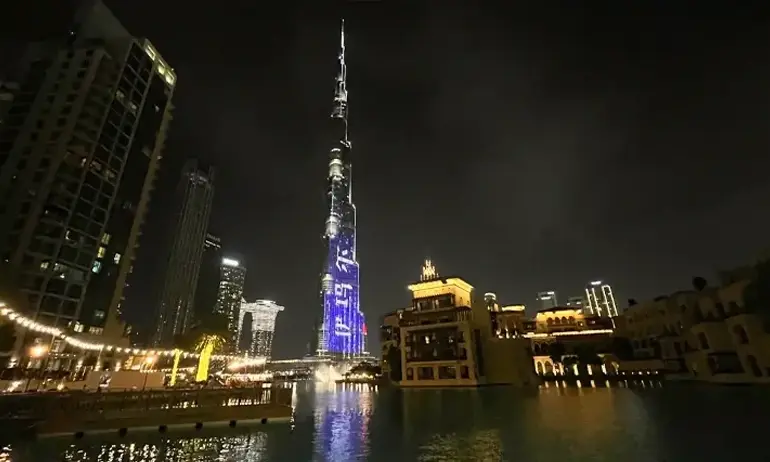
Dubai in 1972 and 2015, the Changes over 43 Years of Dubai
Bandar Rashid made its debut in 1972, marking a significant milestone for Dubai. Initially featuring a deep-sea port with 11 berths, which later expanded to 35, Dubai established itself as a key maritime hub in the Persian Gulf. The city's visionary growth continued with the establishment of the Mohammed Bin Rashid Space Center in 2015, following its announcement in 2014. Situated near the Emirates Institute of Advanced Science and Technology, this facility became the cornerstone of the UAE's space operations and research initiatives. This transformation is a prime example of the dramatic 'Dubai before and after' evolution, showcasing Dubai's rapid progress from a regional port to a global leader in advanced technology and space exploration.
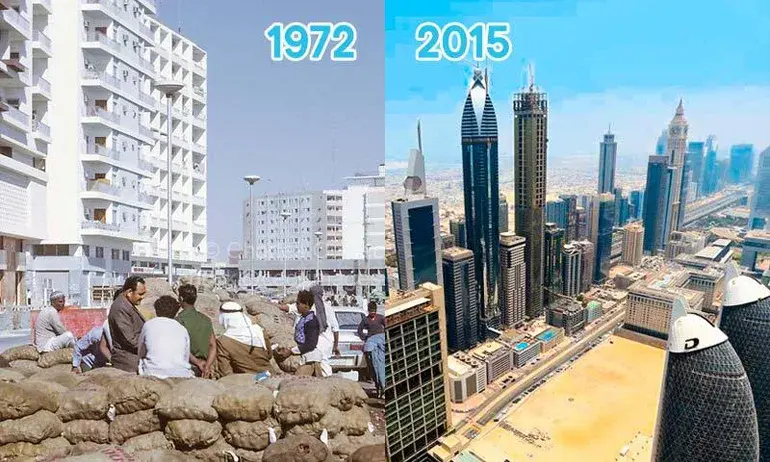
What Happened in Dubai in 1985 and 2014?
Discussing the transformation of Dubai before and after could fill hours. A pivotal moment in this narrative was in 1985, when Emirates Airlines commenced operations, symbolizing Dubai's burgeoning global connectivity.
By 2014, Dubai International Airport had ascended to the top, surpassing London's Heathrow to become the world's busiest airport. With three terminals accommodating over 100 airlines and offering flights to 240 destinations, both major and minor worldwide, the airport's passenger count was projected to exceed 90 million by the end of 2018. This milestone underscores Dubai's evolution into a critical hub for international air travel.
✔️Read More : Dubai | the World’s Best Destination
The Palm Dubai Before and After
The Palm Jumeirah project, a monumental earthworks endeavor, was initiated in 2001 north of Jebel Ali in Dubai. Utilizing advanced technology to deposit sand from the seabed, the project sculpted a palm-shaped island and a crescent-shaped breakwater from the ocean floor, ultimately spanning over 560 hectares. Subsequently, this area saw the development of hotels and private residences, all connected to mainland Dubai by a land road and a monorail.
Construction on the Palm Jumeirah began earnestly in June 2001. By 2006, the first residential units were handed over to occupants, with 75% of the homes ready and 500 families already settled on the island. The development continued to thrive, and by the end of 2009, 28 hotels had opened along the Crescent, marking a significant milestone in the transformation of Dubai's coastline.
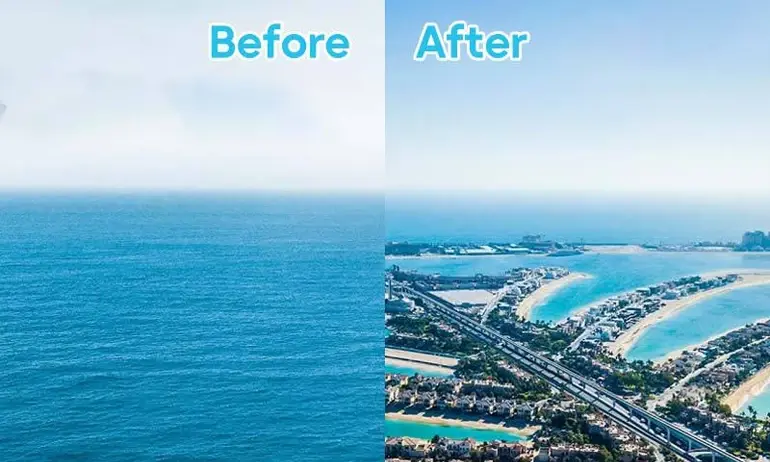
What Did Dubai's Sights Look Like in the Past?
What did Dubai's landmarks look like in the past? Many of Dubai's most famous landmarks have undergone dramatic transformations over the years. The changes are so profound that, comparing past and present photos, you might not believe you're looking at the same locations.
Sheikh Zayed Road in the 1990 vs. Now
Sheikh Zayed Road, the main artery connecting Dubai and Abu Dhabi, holds the distinction of being the longest road in the UAE. Construction of this monumental roadway commenced in 1971 and spanned over nine years. Initially known as Defence Road, it is now flanked by iconic Dubai landmarks like the Emirates Towers, Palm Jumeirah, and Dubai Marina, weaving through the heart of the city’s architectural marvels.
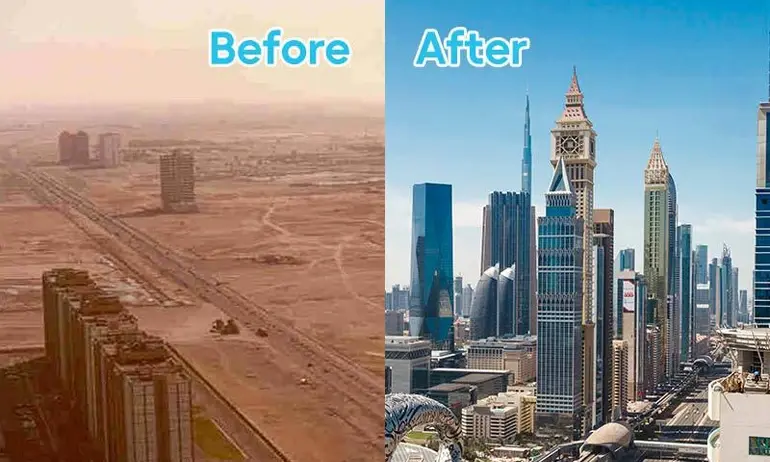
Dubai Marina in 2000 vs. Now
Dubai Marina is an artificial canal city, stretching along three kilometers of the Persian Gulf shoreline. The construction involved channeling Gulf waters to create a man-made marina at the selected site. Among its standout landmarks are the Jumeirah Beach Resort and the Al Rahim Mosque. Renowned as the world's largest man-made marina, Dubai Marina has significantly influenced Dubai’s historical and architectural landscape.
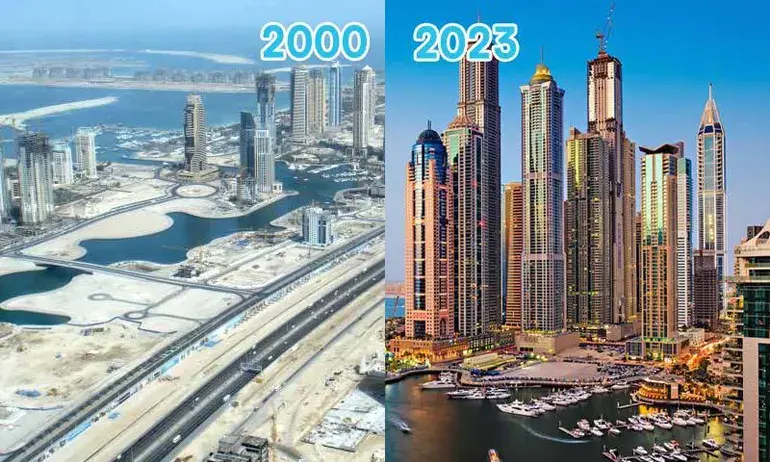
Dubai Waterfront in 1954 vs. Now
The Dubai Waterfront City project features an intricate network of canals and an artificial archipelago. Construction of this ambitious 8-kilometer-long wharf, running parallel to the Persian Gulf coast, commenced in February 2007. However, progress was temporarily halted due to a financial crisis in Dubai at the time. Undoubtedly, this pier serves as a striking testament to Dubai's dynamic history.
.webp)
Dubai Creek in 1950 vs. Now
Dubai Creek has played a pivotal role in shaping the city's history by dividing it into two significant districts: Deira and Bur Dubai. This strategic waterway initially attracted the Bani Yas tribe, Dubai’s earliest settlers, to the area. In the nineteenth century, they founded their settlement around the Bur Creek area and established the Al Maktoum dynasty, setting the foundation for this thriving metropolis. For those eager to explore this historically rich region, it is advisable to rent a car in Deira, Dubai, to navigate comfortably and experience the area's heritage fully.
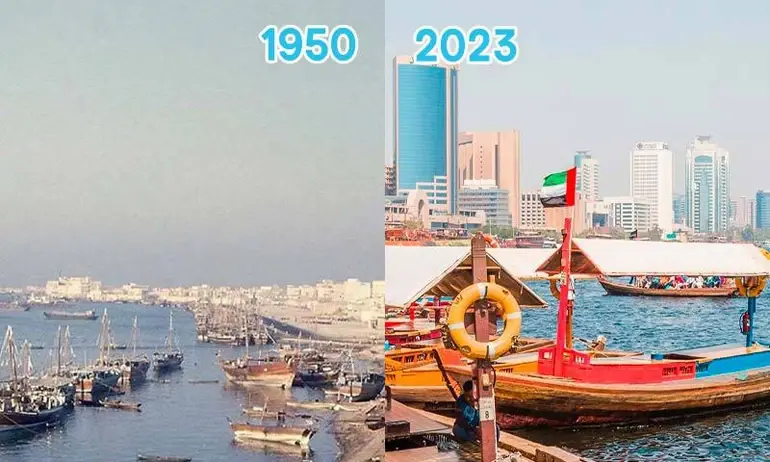
Dubai Airport in 1960 vs. Now
In 1959, Sheikh Rashid bin Saeed Al Maktoum spearheaded the creation of Dubai City Airport, initially featuring an 1800-meter runway composed of compacted sand. As Dubai’s aviation history unfolded, the airport later saw significant upgrades, including an asphalt runway and a dedicated fire station. Today, it stands as one of the busiest airports in the world, testament to its dynamic growth and strategic importance.
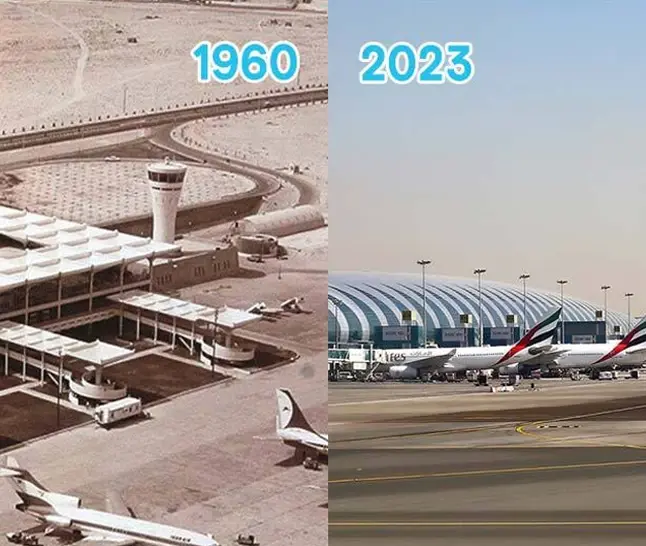
Has Dubai's Architectural Evolution Changed from the Past Until Now?
Yes, Dubai's architectural evolution has been quite dramatic and rapid over the past few decades. Here's a brief overview of how it has transformed:
- Pre-1960s - Traditional Arab Settlements:
Before the oil boom transformed its landscape, Dubai was primarily a quaint fishing village and a crucial hub in the pearl trade. The architecture of that era was ingeniously adapted to the harsh desert conditions. Structures were built using indigenous materials like coral, gypsum, and palm fronds, which were readily available and suited to the climate. The distinctive wind-tower architecture, known locally as 'Barjeel,' was especially notable. These towers served as an early form of air conditioning, ingeniously designed to funnel cool air into buildings, providing relief from the desert heat.
- 1960s - Discovery of Oil:
The discovery of oil ushered in a new era of prosperity for Dubai, catalyzing the modernization of its infrastructure. This period saw the emergence of the first wave of modern buildings, alongside the establishment of essential facilities such as hospitals, schools, and ports. Despite these advancements, the city retained its traditional architectural elements, blending the new with the old to create a unique urban landscape.
- 1980s - Rapid Urbanization:
In the 1980s, Dubai began embracing international architectural styles, aligning with its strategic vision to diversify away from oil dependency and boost sectors like tourism and business. This era marked the rise of numerous hotels, resorts, and towering skyscrapers. A landmark achievement was the construction of the Dubai World Trade Centre in 1979, a pioneering edifice that soared to 39 stories, symbolizing Dubai’s ambitions on the global stage.
- 1990s to Early 2000s - Iconic Structures:
This period was characterized by the construction of ambitious projects and iconic structures that shaped Dubai's skyline. Notably, the Burj Al Arab, completed in 1999, quickly became an international symbol of Dubai’s luxury and innovation. Its distinctive sail-shaped design, set on its own artificial island, underscored Dubai’s aspiration for global recognition.
- Late 2000s to Present - Pushing Boundaries:
The architectural evolution in Dubai reached unprecedented heights with the completion of the Burj Khalifa in 2010, the world's tallest building. Concurrently, Dubai embarked on ambitious projects like the Palm Jumeirah, an artificial island dotted with luxury villas and hotels. The city masterfully melded futuristic designs with cultural elements, exemplified by landmarks such as the Dubai Opera, further cementing its status as a global icon of architectural innovation.
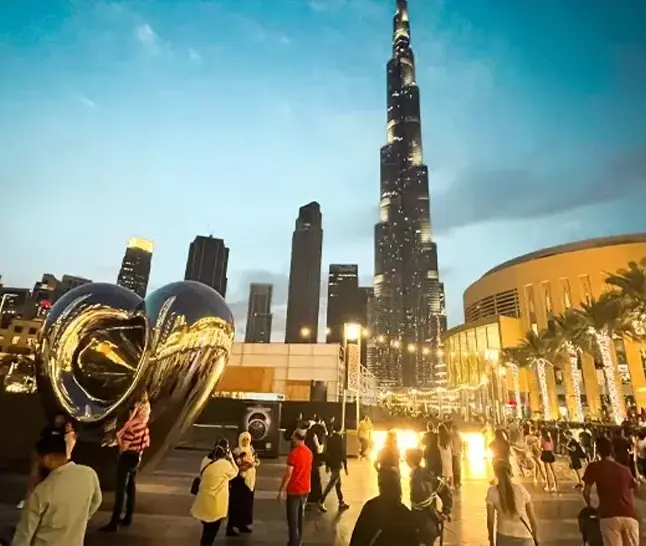
- Sustainability Focus:
As global awareness of environmental issues intensified, Dubai responded by integrating sustainable designs and technologies into its building practices. Notable developments like Dubai Sustainable City exemplify this shift, emphasizing green spaces, solar energy, and eco-friendly living solutions.
In summary, Dubai's architectural landscape has undergone a profound transformation, evolving from modest desert dwellings to striking modern skyscrapers and eco-conscious structures within mere decades. This progression not only highlights the city’s rapid growth and globalization but also underscores its ambition to position itself as a leading global metropolis.
Last word
In response to the question, 'When will Dubai transformation finish?' the answer is clear: Dubai is never finished! Booming since 1901, the city-state continuously evolves with a plethora of exciting plans for the future. The stark contrast between Dubai before and after is a testament to its dynamic growth and ambitious vision. Therefore, consider Dubai as your next destination to fully immerse yourself in the vibrant tourist attractions and witness the ever-expanding horizon of this extraordinary city.
FAQ
How did Dubai get so rich?
In the 1960s, Abu Dhabi discovered a significant amount of oil and gas, making the capital the richest emirate in the United Arab Emirates. Dubai, like Abu Dhabi, discovered oil on its soil, but in far lesser quantities. Dubai recognized at the time that oil earnings would considerably enhance Dubai's position as a luxury resort.
How did Dubai grow so fast?
Rashid al Maktoum is largely considered the driving force behind Dubai's rapid development, which was aided by the discovery of oil. He began dredging the Dubai channel in 1963 because the channel was too narrow for contemporary ships to berth there, causing significant economic consequences.
When was Dubai founded?
June 9, 1833
Dubai is in which country and continent?
Dubai is in Asia, but it is also in the Middle East, which is also in Africa. Dubai is not a country; it is a city and emirate of the United Arab Emirates, which is a transcontinental entity including both Asia and Africa.
Dubai is in which country and continent?
Dubai is in Asia, but it is also in the Middle East, which is also in Africa. Dubai is not a country; it is a city and emirate of the United Arab Emirates, which is a transcontinental entity including both Asia and Africa.
Was Dubai built by slaves?
Most people are familiar with Dubai because of its huge buildings and luxury hotels, but few are aware that the city was created by modern-day slaves.
Has Dubai Silicon Oasis changed from the past until now?
Yes, Dubai Silicon Oasis (DSO) has undergone significant changes since its inception. You can use a car rental Dubai silicon oasis to visit this place.




.webp)

